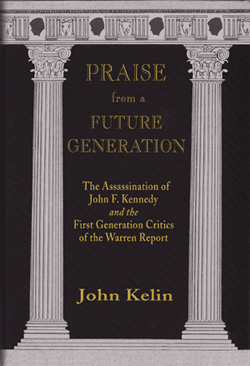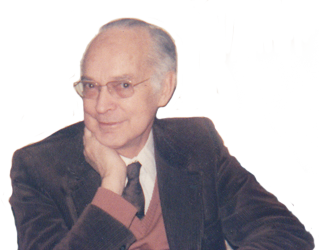 One of the books in which my father is mentioned is Praise from a Future Generation
One of the books in which my father is mentioned is Praise from a Future Generation, by John Kelin. The subtitle is The Assassination of John F. Kennedy and the First Generation Critics of the Warren Report. It’s a fascinating look into the human dimensions and dynamics of the early critics, and a historical chronicle without any interjection of the author’s own theories about the assassination, except to say that it was “indisputably the result of a criminal conspiracy.”
Kelin interviewed many of the people it’s about, and had access to source documents such as letters between them. At the time he wrote the book, he had little information about my father, Thomas G. Buchanan, who wasn’t part of the main circle of researchers who interacted with each other. My father’s book, however, is mentioned as early as the first page of Kelin’s Introduction:
I had no sense of Warren Commission criticism until the mid-1970s. For some reason there was a copy of Thomas G. Buchanan’s Who Killed Kennedy? lying around the house, but I hadn’t read it. Then in the fall of 1976 I attended a lecture by Mark Lane […]
In a way, that lecture was the genesis of this book. I went home and read Buchanan, which was useful in spite of its 1964 publication date.
Elsewhere in the book, my father’s name is mentioned a few times in connection with the reactions of various people to the books and theories about the JFK assassination:
I. F. Stone is quoted as saying:
The Joesten book is rubbish, and Carl Marzani—whom I defended against loose charges in the worst days of the witch hunt—ought to have had more sense of public responsibility than to publish it. Thomas G. Buchanan, another victim of witch hunt days, has gone in for similar rubbish in his book, Who Killed Kennedy? You couldn’t convict a chicken thief on the flimsy slap-together of surmise, half-fact and whole untruth in either book.
Fred Graham, in reviewing Rush to Judgment and The Oswald Affair for The New York Review of Books in 1966, is quoted as having said that this “second round” of books on the assassination was “based upon more research and reflection” than earlier ones like Who Killed Kennedy? and Oswald: Assassin or Fall Guy?, which he claimed had been “largely discredited.”
Johnny Carson, in introducing Jim Garrison as his guest on The Tonight Show in 1968, is quoted as having said, “I felt, personally, as an individual, that enough theorists, including Mark Lane, Buchanan, many many others – Weisberg – had proposed enough theories, and the American public was confused enough. And then about a year ago, the District Attorney of New Orleans, Mr. Jim Garrison, came up with something that kind of astounded the world, when he announced that he had solved the Kennedy assassination.”
My father’s name also comes up a few times in connection with some press kits of which he was one of the recipients.
For instance, Kelin mentions Lillian Castellano’s document as a list of all the problems she had found with the official story. He says she sent it to “the Warren Commission, numerous media outlets, and anyone else she could think of.” She is quoted as saying, “Not one answered me except Thomas Buchanan, the man who wrote Who Killed Kennedy?”
Another press kit my father received contained the Moorman photograph, which was blown up to show the possibility that some of the shadowy shapes behind the grassy knoll may have been armed men. Kelin reports that Michaelangelo Antonioni, the director of the film Blow-up, acknowledged to Ray Marcus that he’d “seen some of the Moorman details that appeared in several European magazines a year or so earlier.” Kelin clarifies that “The articles had been written by Thomas G. Buchanan, one of the recipients of the Moorman press kits Marcus and David Lifton had sent out during the summer of 1965.”
Sylvia Meagher also saw the Moorman photograph. Kelin reports that she sent a letter to Maggie Field, in which she expressed hesitation in informing Léo Sauvage about it.
Sylvia was concerned about Sauvage’s attitude toward Mark Lane, which was decidedly negative, and that he had engaged in a public back-and-forth with Thomas Buchanan in the “Letters” section of The New Leader, which had included what Sylvia considered some gratuitous insults. “So I continue to hesitate.”
A few pages later, Kelin mentions that Maggie Field, too, “was irritated with Sauvage over his attacks on Thomas Buchanan and Mark Lane. His differences with Buchanan, she felt, should have remained private; and to say that Lane had not made any real contributions to the case was unfair.”
My father is named again in another mention of Léo Sauvage. Kelin reports that Sauvage sparked a heated debate at a meeting of what Meagher called “Warrenologists,” which took place in October 1965.
He said that in its anxiety to refute Lane and Thomas Buchanan during the months before the Warren Report was published, the Commission succeeded only in making parts of its case more vulnerable.
The section of Kelin’s book that gives my father the most coverage is in the chapter called The Oswald Affair. On page 173, after talking about Joachim Joesten’s book Oswald: Assassin or Fall Guy? as the first critical book to be published in the U.S., Kelin then writes:
But the first book anywhere was Who Killed Kennedy? by Thomas G. Buchanan, a former Washington Star reporter then living in Paris. His work began as a series of articles published in l’Express in early 1964. This got the attention of the Warren Commission. Richard Helms sent CIA Director John McCone a memo stating in part:
1. A competent American observer learned, in Paris on 10 April 1964, that Secker and Warburg Ltd., in London, will publish as a book the Thomas Gittings Buchanan articles which have appeared in Paris in l’Express. The publishing firm is also approaching publishers in the United States and the firm is rushing its edition, hoping to have it on sale by 15 May 1964.
2. Buchanan’s thesis is that the assassination of President Kennedy was the product of a rightist plot in the United States. He alleges in his articles that the slain Dallas policeman Tippett [sic] was part of the plot against President Kennedy…
Who Killed Kennedy? was indeed published first in England in the spring of 1964, and in the United States later that year. The mainstream media made much of the fact that Buchanan had been fired from the Washington Star in 1948 for membership in the Communist Party. But in a review of the book published in The Minority of One, Cedric Belfrage said it was irrelevant whether Buchanan was a former Communist or a former Zen Buddhist; what was important was his “common sense of the assassination and the American crisis it symbolizes.”
The immediate reaction of most of the world, Buchanan asserted, was “to assume a link between the Kennedy assassination and the recent violence by Southerners against the Negro.” This violence included the assassination of Medgar Evers, and the bombing of the Sixteenth Street Baptist Church in Birmingham, Alabama, in which four young girls were killed. It also included the slaying of William Moore, a white mail carrier shot down during a quixotic march to Jackson, Mississippi, in April 1963.
Oswald was probably not a genuine Communist, Buchanan wrote; surely a government agency like the FBI or CIA had an interest in him. How else, for example, could a former defector to the Soviet Union have applied for a passport to return there and not only received it, but received it within twenty four hours? If nothing else, under terms of the McCarran Act, a real Communist would first have been thoroughly investigated.
The true perpetrators of the assassination, Buchanan concluded, were Texas oil millionaires motivated by President Kennedy’s decision to eliminate an oil-depletion allowance that would have cost them millions of dollars.
In granting me permission to quote these passages, the author recently expressed the following thought:
“When I said, ‘Who Killed Kennedy? was weakened in places by Buchanan’s speculations,’ that was probably not very fair. When I wrote that, I had the advantage of forty-some years of hindsight, whereas TGB was writing about a current event that was still taking shape. I regret that, and not just because I’ve been corresponding with you.”
Who Killed Kennedy? was weakened in places by Buchanan’s speculations. But it was quite effective in a section that reviewed the three previous Presidential assassinations in American history: those of Abraham Lincoln, James Garfield, and William McKinley. The assassins John Wilkes Booth, Charles A. Guitteau, and Leon Czolgosz were uniformly portrayed in the media as loners and psychopaths. Buchanan reminded his readers that Lincoln’s assassination was a conspiracy for which four people were hanged and others imprisoned, and that Garfield’s assassination too had elements of a plot. And he showed that none of these assassins were insane by the usual definition of the term. The same was probably true of Lee Harvey Oswald. “If Lee Harvey Oswald were alive today,” Buchanan wrote, “the same people who are now insisting he was crazy would have been the first…to demand that he be punished as a sane man for premeditated murder.” Moreover none of the earlier assassins denied their deed – rather they were proud of it. Lee Oswald, on the other hand, insisted that he had not killed anyone.
There is one sentence in particular, that my father wrote, that stuck with Kelin. He used it as a quote to introduce Part Three of his book:
It is not the light that we must fear; it is the darkness
— Thomas G. Buchanan, Who Killed Kennedy?
In our personal correspondence, Kelin has said, “That line had a really big impact on me the first time I read it, and continues to have an impact on me now, as both powerful rhetoric and as poetry.”
The final time John Kelin quotes from my father’s book is in the following passage:
In his 1964 book Who Killed Kennedy?, Thomas G. Buchanan observed that the facts of the assassination as they were initially reported in the media changed several times, but the conclusion of Oswald’s lone guilt never changed. “If, as a statistician, I were solving problems with the aid of a machine and I discovered that, however the components of my problem were altered, the machine would always give me the same answer, I should be inclined to think that the machine was broken.”
In reading Praise from a Future Generation, what I was originally interested to see was what kind of awareness there was of my father, not just among the other early critics but also in the American media. John Kelin didn’t have enough personal information about my father to write the same kind of up-close-and-personal story that he tells about some of the other critics. But his access to their personal correspondence has allowed him nevertheless to give a sense of the place my father occupied in their minds.
In any case, I have to say that, regardless of how much or how little coverage my father received, I found the story of the other “first generation critics” a fascinating read.
